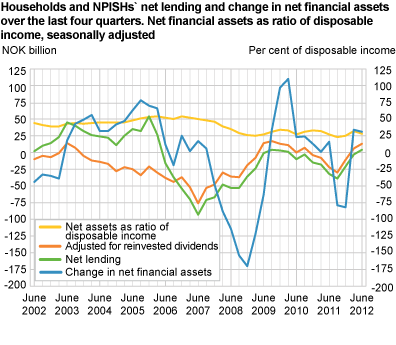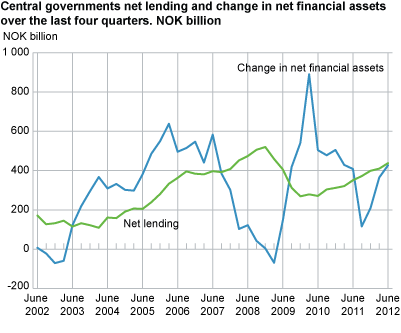Content
Published:
This is an archived release.
Households choose safe deposits
The growth in households’ bank deposits continues, while investments in securities are modest. The debt growth has been stable in the five last quarters.
Households and non-profit institutions serving households increased their net lending by NOK 6 billion in the four-quarter period to the second quarter of 2012. The main picture is characterised by the increase in bank deposits, which has been particularly high from the fourth quarter of 2011. In the last four-quarter period, transactions in currency and deposits totalled NOK 77 billion, while investments in securities barely amounted to NOK 3 billon.
Stable debt growth, but higher debt to income ratio
The estimated annual growth rate for households’ total debt over the last five quarters has varied from 7.0 per cent to 7.2 per cent in the second quarter of 2012. The growth rate increased by 0.2 percentage points in the last four-quarter period due to loans and other debt, which both increased slightly more than in the previous four-quarter period to the first quarter of 2012.
Household debt continues to increase faster than income. The quarterly seasonally-adjusted debt to income ratio - total debt as a percentage share of disposable income - increased by 1.0 percentage point to 202.9 per cent at the end of the second quarter of 2012. However, the debt to income ratio was influenced by the revised institutional sector classification that was implemented in important source statistics from the first quarter of 2012, and which has led to a break in the time series for stock in the financial accounts. Adjusted time series for debt show that the seasonally-adjusted debt to income ratio has increased every quarter from the end of the third quarter of 2010 to the end of the second quarter of 2012.
Financial investments abroad increase state’s net financial assets
Central government’s net financial assets increased by NOK 427 billion over the last year to the end of the second quarter of 2012. In the four-quarter period, the state’s net financial assets were strongly affected by the market fluctuations in securities markets. In particular, the drop in share prices in the third quarter of 2011 and the second quarter of 2012 contributed to holding losses for central government of NOK 11 billion. At the same time, net lending was NOK 438 billion, which is NOK 28 billion higher than in the previous four-quarter period to the first quarter of 2012. Central government’s net financial assets were NOK 4 783 billion at the end of the second quarter of 2012. Of this, the market value of the Norwegian Government Pension Fund Global amounted to NOK 3 561 billion.
Local government’s borrowing drops
Local government’s net lending is estimated at NOK -16 billion in the four-quarter period to the second quarter of 2012. This is up by NOK 2 billion from the previous four-quarter period, mainly as a result of a falling trend in borrowing in the last two four-quarter periods. In the period to the second quarter of 2012, local government borrowed NOK 33 billion compared to NOK 35 billion in the previous four-quarter period. Total debt amounted to NOK 468 billion at the end of the last quarter. Net debt decreased by NOK 20 billion in the second quarter of 2012 to NOK 139 billion at the end of the quarter.
Net foreign assets continue to increase
Norway’s net foreign assets are estimated at NOK 2 875 billion at the end of the second quarter of 2012. This is an upturn by NOK 77 billion from the end of the first quarter of 2012. Norway’s net lending abroad was NOK 90 billion in the second quarter of 2012, which is down NOK 55 billion from the previous quarter. Net holding losses, mainly due to developments in global security markets, decreased the value of net financial assets abroad by NOK 13 billion in the second quarter of 2012.
| 1. quarter 2010 | 2. quarter 2010 | 3. quarter 2010 | 4. quarter 2010 | 1. quarter 2011 | 2. quarter 2011 | 3. quarter 2011 | 4. quarter 2011 | 1. quarter 2012 | 1. quarter 2012 | ||||||||||||||||||||||||||||||||||||||||||||||||||||||||||||||||||||||
|---|---|---|---|---|---|---|---|---|---|---|---|---|---|---|---|---|---|---|---|---|---|---|---|---|---|---|---|---|---|---|---|---|---|---|---|---|---|---|---|---|---|---|---|---|---|---|---|---|---|---|---|---|---|---|---|---|---|---|---|---|---|---|---|---|---|---|---|---|---|---|---|---|---|---|---|---|---|---|---|
| Financial assets | 6 318 | 6 678 | 6 648 | 6 877 | 7 103 | 7 006 | 7 230 | 7 179 | 7 628 | 7 647 | |||||||||||||||||||||||||||||||||||||||||||||||||||||||||||||||||||||
| Liabillities | 4 280 | 4 503 | 4 344 | 4 486 | 4 746 | 4 565 | 4 831 | 4 581 | 4 830 | 4 772 | |||||||||||||||||||||||||||||||||||||||||||||||||||||||||||||||||||||
| Net financial assets / net financial wealth | 2 039 | 2 174 | 2 304 | 2 391 | 2 357 | 2 442 | 2 399 | 2 598 | 2 798 | 2 875 | |||||||||||||||||||||||||||||||||||||||||||||||||||||||||||||||||||||
| Change in net financial assets / net financial wealth | 212 | 136 | 129 | 87 | -34 | 84 | -43 | 199 | 200 | 77 | |||||||||||||||||||||||||||||||||||||||||||||||||||||||||||||||||||||
| Other changes | 127 | 59 | 65 | 1 | -118 | -16 | -143 | 90 | 55 | -13 | |||||||||||||||||||||||||||||||||||||||||||||||||||||||||||||||||||||
| Net lending | 85 | 77 | 64 | 86 | 84 | 100 | 100 | 108 | 145 | 90 | |||||||||||||||||||||||||||||||||||||||||||||||||||||||||||||||||||||
DefinitionsNet lending as defined in non-financial accounts (capital account) = savings + net capital transfers - net acquisition of non-financial assets Net lending as defined in financial accounts = net acquisition of financial assets - net incurrence of liabilities Savings is non-consumed income and can be invested in financial or non-financial assets. If savings exceed non-financial investments, a sector has a surplus of funds and becomes a net lender to other sectors. In the financial transaction account, this means that the sector acquires more financial assets than liabilities. On the other hand, if savings are less than non-financial investments, investments have to be funded either by selling financial assets or incurring debts. Household investments in non-financial assets mainly reflect the purchase of new housing and fixed investments by unincorporated enterprises. They typically finance substantial parts of these investments by incurring debt in the form of loans. Net financial assets (net financial wealth) = total financial assets - total liabilities The financial balance sheet shows the financial position of a sector at the end of the reference period and is broken down into the categories of financial assets and liabilities. Insurance technical reserves, currency and deposits are the predominant assets held by households, while loans provided by financial corporations (banks etc.) constitute the main proportion of liabilities. Changes in net financial assets = net lending + other changes in assets, net The change in the financial balance sheet during the reference period is a result of accumulated financial transactions and other changes in assets. The latter category mainly reflects revaluations due to changes in market prices of financial instruments. |
Contact
-
Torbjørn Cock Rønning
E-mail: torbjorn.cock.ronning@ssb.no
tel.: (+47) 97 75 28 57
-
Jon Ivar Røstadsand
E-mail: jon-ivar.rostadsand@ssb.no
tel.: (+47) 21 09 43 69
-
Marit Eline Sand
E-mail: marit.sand@ssb.no
tel.: (+47) 40 90 26 74


